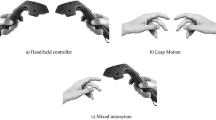Abstract
In this paper, seven methods are described to perform remote object translations with a six degree-of-freedom input device in an immersive virtual environment. By manipulating objects remotely, a number of disadvantages of the real-world ‘direct grab and drag’ metaphor can be avoided. The different methods are evaluated with a pilot user experiment. From the results of the experiment, some initial recommendations are formulated on the use of the methods for different manipulation tasks.
Access this chapter
Tax calculation will be finalised at checkout
Purchases are for personal use only
Preview
Unable to display preview. Download preview PDF.
Similar content being viewed by others
References
D.A. Bowman and L.F. Hodges. An evaluation of techniques for grabbing and manipulating remote objects in immersive virtual environments. In S.N. Spencer, editor, 1997 Symposium on Interactive 3D Graphics, pages 35–38, 1997.
S. Bryson. Approaches to the successful design and implementation of VR applications. In R.A. Earnshaw, J.A. Vince, and H. Jones, editors, Virtual Reality Applications, pages 3–15. Academic Press, 1995.
C. Cruz-Neira, D.J. Sandin, and T.A. DeFanti. Surround-screen projection-based virtual reality: The design and implementation of the CAVE. In Computer Graphics (SIGGRAPH ‘93 Proceedings), volume 27, pages 135–142, 1993.
L.D. Cutler, B. Fröhlich, and P. Hanrahan. Two-handed direct manipulation on the responsive workbench. In S.N. Spencer, editor, Proceedings of the 1997 Symposium on Interactive 3D Graphics, pages 107–114, 1997.
K. Hinckley, R. Pausch, J.C. Goble, and N.F. Kassell. A survey of design issues in spatial input. In Proceedings of the ACM Symposium on User Interface Software and Technology (UIST’ 94), pages 213–222, 1994.
W.S. Kim, F. Tendick, S.R. Ellis, and L.W. Stark. A comparison of position and rate control for telemanipulators with consideration of manipulator dynamics. IEEE Journal of Robotics and Automation, RA-3(5):426–436, October 1987.
J.D. Mulder and J.J. van Wijk. 3D computational steering with parametrized geometric objects. In G.M. Nielson and D. Silver, editors, Visualization’ 95 (Proceedings of the 1995 Visualization Conference), pages 304–311, 1995.
C. Schmandt. Spatial input/display correspondence in a stereoscopic computer graphic work station. Computer Graphics, 17(3):253–261, 1983.
J.W. Tukey. Exploratory Data Analysis. Addison-Wesley, 1977.
C. Ware. Using hand position for virtual object placement. Visual Computer, 6(5):245–253, 1990.
S. Zhai and P. Milgram. Human performance evaluation of manipulation schemes in virtual environments. In Proceedings of the 1993 IEEE Virtual Reality Annual International Symposium, pages 155–161, 1993.
S. Zhai, P. Milgram, and A. Rastogi. Anisotropic human performance in six degree-of-freedom tracking: An evaluation of three-dimensional display and control devices. IEEE Transactions on Systems, Man, and Cybernetics Part A: Systems and Humans, 27(4):518–528, 1997.
Author information
Authors and Affiliations
Editor information
Editors and Affiliations
Rights and permissions
Copyright information
© 1998 Springer-Verlag/Wien
About this paper
Cite this paper
Mulder, J.D. (1998). Remote Object Translation Methods for Immersive Virtual Environments. In: Göbel, M., Landauer, J., Lang, U., Wapler, M. (eds) Virtual Environments ’98. Eurographics. Springer, Vienna. https://doi.org/10.1007/978-3-7091-7519-4_8
Download citation
DOI: https://doi.org/10.1007/978-3-7091-7519-4_8
Publisher Name: Springer, Vienna
Print ISBN: 978-3-211-83233-2
Online ISBN: 978-3-7091-7519-4
eBook Packages: Springer Book Archive




